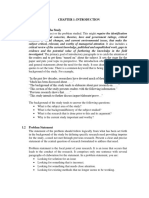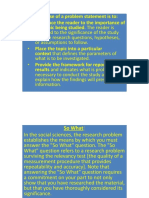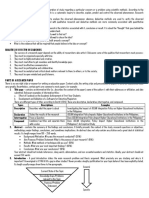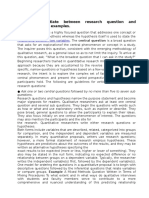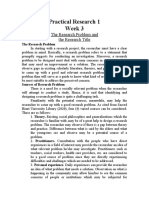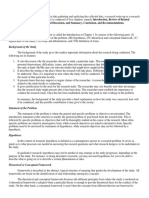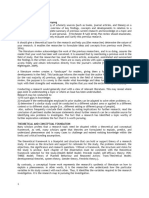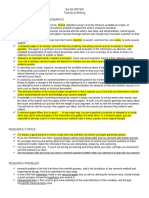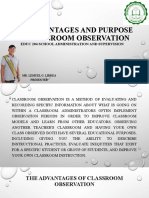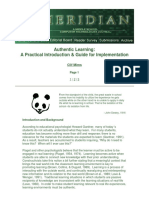When To Start Reviewing Related Literature
When To Start Reviewing Related Literature
Uploaded by
Issa GayasCopyright:
Available Formats
When To Start Reviewing Related Literature
When To Start Reviewing Related Literature
Uploaded by
Issa GayasOriginal Description:
Original Title
Copyright
Available Formats
Share this document
Did you find this document useful?
Is this content inappropriate?
Copyright:
Available Formats
When To Start Reviewing Related Literature
When To Start Reviewing Related Literature
Uploaded by
Issa GayasCopyright:
Available Formats
When to Start Reviewing Related Literature
While the research problem is still being conceptualized, the researcher must already start
reviewing literature. In identifying and defining the research problem, the researcher must be able to
show evidences that the problem really exists and is worth investigating. Information regarding the
existence, seriousness, and relevance of the problem can be gleaned from literature.
It is important that the researcher knows what is already known about the problem or what
earlier researchers have found about it and what questions still need to be answered before the
research questions or objectives are finalized.
Theories which researchers use to explain the existence of a research problem and used as
bases in analyzing relationships between variables can be generated from reference books on theories
or from related studies. The researcher, therefore, must have already read adequate literature at the
start of a research activity.
What to Review and Where to Get the Materials
Researchers should be familiar with the different sources of information related to the research
problem. The most common types of sources of information for a research problem are: general
reference, primary sources, and secondary sources.
General Reference
General References show where to locate other sources of information related to a certain
topic. Examples of general references available in most libraries are indexes, reviews, and abstracts.
Indexes are usually published by field of specialization. For example, in education, there are the
Education Index and Dictionary of Education Research. Commonly used abstract are the Psychological
Abstracts and Social Science Index.
Primary Sources
Results of many research studies are published in journals or monographs. These articles or
reports are generally written by those who actually conducted the study, thus, they are called primary
sources. Many research journals are published monthly, quarterly or yearly. Some of the commonly
used journals in various areas are: Philippines Nursing Journal, Business Journal, Philippine Sociological
Review, Journal of Philippine Business Administration, Social Psychology Journal, Educational Research
Journal, and many others.
Secondary Sources
Secondary sources refer to publications where authors cite the work of others. The most
common secondary sources are books, reviews, yearbooks, and encyclopedias. Secondary sources are
good references for overview of the problem.
Steps in Literature Review
In reviewing related literature, the following steps may be followed:
1. Review the precise definition of the research problem. Note the key variables specified in the
study objectives and hypothesis.
2. Formulate search terms (key words or phrases) pertinent to the problem or question or
interest. For example for the problem: Adolescents Perception on the Effect of Punishment on
Self-esteem and Academic Performance possible search terms could be punishment and
learning self esteem and performance self worth
3. List in a note or index card the bibliographical data of the pertinent sources selected, including
the: a. author of the source, b. its title, c. name of the publication, d. date of publication, and e.
pages of the article.
4. Read the selected reading materials, take notes, and summarize key points. Notes are preferably
written in note cards for easy retrieval and classification. In taking notes, be brief as possible,
but include al l relevant information which you can use in your full review, such as : the problem,
the objectives and hypotheses, the procedures, major findings, and conclusions.
Writing the Literature Review
After taking notes from the different sources reviewed, the researcher prepares the
final review. Most literature reviews consist of the following: parts: introduction, body,
summary/synthesis, and conclusion.
1. Introduction. The introduction briefly describes the nature of the research problem and
explains what led the researcher to investigate the question. The summary presents the
main topics covered in the literature review section.
2. Body. The body of the review briefly reports what experts think or what other researchers
have found about the research problem. Studies done on one key element or factor of the
research problem are reviewed under that topic followed by studies done on other aspects
of the problem. The common findings of several studies are summarized in one or two
sentences and only when necessary, some specific findings of each study may be presented.
3. Summary/synthesis. The summary/synthesis of the literature review ties together the
major findings of the studies reviewed. It presents a general picture of what has been
known or thought of about the problem to date. It points out similar results, as well as
conflicting findings.
Summary of Steps in Identifying and Defining a Problem
1. State the problem situation
Write a short paragraph that describes the discrepancy between what is and what should
be
Write the central problem or the main research question
Give two or more plausible answer to the question (If there is only one plausible answer to
the question, the problem is not researchable)
2. Add details by presenting statistics or any information that can serve as evidence that the problem
really exists. You can derive these from service statistics, related studies, and other existing
documents.
3. Using data from available research literature, current service statistics, educated opinions, and
other sources of information, define further the problem situation you ave just identified.
Hopefully, your review of related studies will reveal concepts and operational variables that you
may have overlooked. If you listed these concepts and variables as you come upon them in your
review of related studies, the task of defining the problem becomes much easier.
4. With the information you have collected from a literature review and other sources, improve your
problem definition and add details that will help explain what your research problem is all about
and why you want to study the problem. Organize the information and your ideas, such that the
readers can be convinced that you really need to undertake the research.
What are Research Objectives?
Research objectives are statements of what the researcher intends to do. The objectives flow
logically from the problem. They can communicate what the researcher plans to do. Structurally, the
objectives are seen as small particles which constitute the problem.
Examples of research objectives:
To determine the extent of high school students participation in school activities
To determine the relationship between exposure to advertising materials and expenditure
patterns of young professionals
To compare the effectiveness of classroom-based and field-based training programs on the
performance of community workers
Examples of objectives stated in question form:
This study sought answers to the following questions:
1. To what extent do high school students participate in school activities?
2. Does extent of participation in school activities of male students significantly differ from the
extent of participation of female students?
3. Is there a significant relationship between the students extent of participation in school
activities and their school performance?
Type of Objectives
There are two kinds of objectives usually formulated for a research study, the
immediate/general objective and the specific objective
Immediate/general objectives
The immediate/general objective relates directly to the research problem and states clearly
what the researcher will do and expects to find out. The immediate/general objective is preferably
stated in behavioral terms- in terms of: who or what will be studied, who will do it, when it will be done,
or where it will be done.
Example of Immediate/General Objectives of a Curriculum/Relational Study
Research Title: Exposure to Advertising and Expenditure Patterns of Young Professionals in Iloilo City
Objective: This study will be conducted to determine whether there is a significant relationship between
exposure to advertising and expenditure patterns of young professionals in Iloilo City
What will be done? This study will be conducted
For what purpose? To determine whether there is a significant relationship between exposure to
advertising and expenditure patterns
Who will be studied? Young professionals
Where? Iloilo City
When? (Not specified)
Specific Objectives
In studies with a broader coverage in terms of subjects and variables, statement of specific
objectives may be necessary. Specific objectives may be viewed as sub-objectives or small particles of
the general objective.
Examples of Statements of General and Specific Objectives
Relationship between TV Watching and Academic Performance of Grade Six Pupils in Private and Public
Elementary School in Region VI
General Objective
The study will be conducted to determine the existence and degree of relationship between TV
viewing and Academic Performance of Grade Six Pupils in Private and Public Elementary School in
Region VI
Specific Objectives
Specifically, the study aims to:
1. Determine whether there is a significant relationship between the pupils frequency of viewing
TV and their general average in all subjects in grade six.
2. Determine whether there is a significant relationship between the amount of time spent by the
pupils in viewing TV and their general average in all subjects in grade six
Hypotheses
Researchers make educated guesses to tentatively answer the research questions. Usually they
make tentative answers to the research questions. From these they select the more logical and
theoretically sound guesses. These tentative answers to the research question/s are called hypotheses
What is a Hypothesis?
A hypothesis is defined as an educated guess or a tentative answer to a question. It is a
statement about an expected relationship between two or more variables that can be empirically
tested.
Hypotheses are usually tested in intervention or evaluation studies and in correlation/relational
studies. Purely descriptive studies or diagnostic and exploratory investigations do not normally require
hypothesis statements because they generally do not test casual relationships between variables.
A hypothesis suggests the type of analysis that must be done in order to measure the
relationship.
Null Hypothesis vs. Alternative Hypothesis
A null hypothesis is a negative statement which indicates the absence of a
relationship/correlation between two variables, an absence of a significant difference between the
proportions of two groups of people or objects possessing a particular characteristic or an absence of
difference between or among the means of two or more groups with respect to a particular variable,
such as mean age of males and mean age of females.
Example of Null Hypothesis
There is no significant relationship between mass media exposure and attitude towards land
reform among lowland farmers
An alternative hypothesis, also called the research hypothesis, is the positive form of the null
hypothesis. It may state the presence of a significant relationship between the independent and
dependent variables, or the presence of a significant difference between two means or two proportions.
Example of Alternative Hypothesis
There is a significant relationship between mass media exposure and attitude towards land
reform among lowland farmers
Research Frameworks
A problem exists because of certain reasons. Even if the cause or causes of a problem cannot be
pinpointed, its existence may be discussed by examining certain patterns that relate to the problem
situation. In explaining the existence of a problem, a researcher may base the explanation on a theory.
The connection between a theory and the problem is explained in the theoretical framework. The
theoretical framework may further be explained and illustrated in concrete terms using a conceptual
framework.
The Role of Theory in Research
A theory is a set of concepts which explains the occurrence of a certain phenomenon. It is a
statement of relationship between two variables, one acting as the independent variable, another ass
the dependent variable. An independent variable is assumed to be the cause of the problem, while the
dependent variable is the problem itself or the phenomenon being studied.
You might also like
- The Philippine Legal SystemDocument21 pagesThe Philippine Legal SystemIssa GayasNo ratings yet
- Statutory Construction - Power PointDocument32 pagesStatutory Construction - Power PointIssa Gayas100% (9)
- HSC 440 Sample Learning OpportunityDocument7 pagesHSC 440 Sample Learning Opportunityapi-355220460No ratings yet
- BSED Physical Education (HOPE 1) Sample Daily Lesson LogDocument4 pagesBSED Physical Education (HOPE 1) Sample Daily Lesson LogNeil Jasper Ducut100% (7)
- Lecture Notes 5. Review of Related LiteratureDocument4 pagesLecture Notes 5. Review of Related Literaturelander100% (2)
- Literature Review AschapDocument8 pagesLiterature Review AschapSaad Bin SadaqatNo ratings yet
- Outline DescriptionDocument11 pagesOutline Description魔渝No ratings yet
- 3rd MeetingDocument9 pages3rd Meetingetnika loakNo ratings yet
- Reserch Problem FormulationDocument3 pagesReserch Problem Formulationamul65No ratings yet
- CARS-3-The Research ProblemDocument28 pagesCARS-3-The Research ProblemJoanna Felisa GoNo ratings yet
- RRL CapstoneDocument3 pagesRRL CapstoneAkala ko Ikaw ay akinNo ratings yet
- Research Proposal Writing - Summary - April 2024Document15 pagesResearch Proposal Writing - Summary - April 2024clinicsecNo ratings yet
- Research Seminar GuidelinesDocument11 pagesResearch Seminar GuidelinesShruti JainNo ratings yet
- How To Write A Scientific Research Paper - Dr. B.T.LawaniDocument9 pagesHow To Write A Scientific Research Paper - Dr. B.T.LawaniThe State AcademyNo ratings yet
- Chapter 1 (Subtopics and Mechanics of Writing)Document6 pagesChapter 1 (Subtopics and Mechanics of Writing)Noemie BuñiNo ratings yet
- Imrad StyleDocument18 pagesImrad Styleezradaan0910No ratings yet
- DLS ENGLISH 10 Lesson 29Document9 pagesDLS ENGLISH 10 Lesson 29Ivan Miguel MariNo ratings yet
- 5Review of LiteratureDocument19 pages5Review of LiteratureJoy Zel Mae GarnicaNo ratings yet
- What Is ResearchDocument5 pagesWhat Is ResearchCfosh Lspu-sccNo ratings yet
- The Research ProblemDocument12 pagesThe Research ProblemhithereNo ratings yet
- Unit 4: Learning From Others and Reviewing The LiteratureDocument31 pagesUnit 4: Learning From Others and Reviewing The Literaturegmpimentel2221lagNo ratings yet
- I. Types and ContentDocument4 pagesI. Types and ContentupenderNo ratings yet
- Q.2 Differentiate Between Research Question and Hypothesis. Give ExamplesDocument21 pagesQ.2 Differentiate Between Research Question and Hypothesis. Give ExamplesHafiz AhmedNo ratings yet
- res01manuscriptguidebook.Document14 pagesres01manuscriptguidebook.Gian Titus GanhinhinNo ratings yet
- OUTLINE - Review of Related LiteratureDocument4 pagesOUTLINE - Review of Related LiteratureDennyTemplonuevoNo ratings yet
- Lecture 2Document9 pagesLecture 2ClarkJimrex AlejoNo ratings yet
- I3 ReviewerDocument4 pagesI3 ReviewerEvelyn BautistaNo ratings yet
- Fundamentals of Research Assignment 3Document9 pagesFundamentals of Research Assignment 3CassyNo ratings yet
- PHD001 - RM - Question BankDocument22 pagesPHD001 - RM - Question BankSagar GajeraNo ratings yet
- Chapter 3Document42 pagesChapter 3Jemal Abdu SeidNo ratings yet
- Assignment The Purpose Statement Date: - 20-02-2020Document11 pagesAssignment The Purpose Statement Date: - 20-02-2020Muhammad Bilal100% (1)
- Title Background and Statement of The ProblemDocument19 pagesTitle Background and Statement of The ProblemHazelNo ratings yet
- Lesson 2 Research ProblemDocument54 pagesLesson 2 Research ProblemCbrc BulacanNo ratings yet
- Fundamentals of Review of LiteratureDocument4 pagesFundamentals of Review of LiteratureJesah Christa MontañoNo ratings yet
- Guidelines in Writing The Research ProposalDocument8 pagesGuidelines in Writing The Research ProposalGail AltheaNo ratings yet
- Intro To Research HandoutsDocument10 pagesIntro To Research HandoutsArmiera RamirezNo ratings yet
- Hand Out pr1Document6 pagesHand Out pr1Maryfhel LeyteNo ratings yet
- What Is ResearchDocument6 pagesWhat Is Researchha ruNo ratings yet
- Thesis Guide Proposal GIGIDocument47 pagesThesis Guide Proposal GIGImaria erika100% (5)
- Module 3Document21 pagesModule 3Jhezmae rose AlonzoNo ratings yet
- Module 2Document5 pagesModule 221-60448No ratings yet
- Practical Research 1 Week 3: The Research Problem and The Research TitleDocument21 pagesPractical Research 1 Week 3: The Research Problem and The Research TitleXYRA LOU SEDANo ratings yet
- How To Review The Literature and Conduct Ethical StudiesDocument4 pagesHow To Review The Literature and Conduct Ethical StudiesAmara Prabasari100% (1)
- Chapter 2Document10 pagesChapter 29125103046No ratings yet
- Organizing Academic Research PapersDocument4 pagesOrganizing Academic Research PapersAloc MavicNo ratings yet
- Abdul SattarDocument44 pagesAbdul SattarKashifntcNo ratings yet
- The Research PaperDocument2 pagesThe Research PaperAirah SantiagoNo ratings yet
- Writing Guide 1Document14 pagesWriting Guide 1fallerkate23No ratings yet
- Senior Research Project GuidelineDocument9 pagesSenior Research Project GuidelinepinkyNo ratings yet
- Practical Research ReviewerDocument10 pagesPractical Research Reviewerclaireagusan1029No ratings yet
- 3Is-Reviewer - Docx 20240322 162954 0000Document4 pages3Is-Reviewer - Docx 20240322 162954 0000mersiarawarawnasahealingstageNo ratings yet
- Lesson 12 Significance of The Study and RRLDocument53 pagesLesson 12 Significance of The Study and RRLJunilyn SamoyaNo ratings yet
- Guideline for Graduate Proposal FormatDocument20 pagesGuideline for Graduate Proposal Formatdejene teferaNo ratings yet
- Lecture 4 - Research MethodsDocument21 pagesLecture 4 - Research MethodsAimanNo ratings yet
- Main Parts of The Business Research PaperDocument5 pagesMain Parts of The Business Research PaperMariel SofiaNo ratings yet
- Defining Research Problem and Hypothesis FormulationDocument31 pagesDefining Research Problem and Hypothesis FormulationBrook AddisuNo ratings yet
- 02 Handout 1Document5 pages02 Handout 1Nor Jhon BruzonNo ratings yet
- III-Reviewer Brainstorming For Research TopicsDocument2 pagesIII-Reviewer Brainstorming For Research TopicsEvelyn BautistaNo ratings yet
- Opt407 2Document5 pagesOpt407 2teamtruth50No ratings yet
- Reviewer in PR1Document3 pagesReviewer in PR1Sam VillegasNo ratings yet
- Educ 113 Lesson 4Document32 pagesEduc 113 Lesson 4John Mark LazaroNo ratings yet
- 3rd Quarter Technical WritingDocument3 pages3rd Quarter Technical WritingDarren CalibugarNo ratings yet
- Participatory Action Research for Evidence-driven Community DevelopmentFrom EverandParticipatory Action Research for Evidence-driven Community DevelopmentNo ratings yet
- Define Citizenship.: Commentary, 2009 Ed.)Document6 pagesDefine Citizenship.: Commentary, 2009 Ed.)Issa GayasNo ratings yet
- Since Feeling Is FirstDocument7 pagesSince Feeling Is FirstIssa GayasNo ratings yet
- Free Certificate TemplateDocument2 pagesFree Certificate TemplateBobrapiNo ratings yet
- Research TerminologiesDocument10 pagesResearch TerminologiesIssa GayasNo ratings yet
- Admin Law and Election Law QuestionsDocument48 pagesAdmin Law and Election Law QuestionsIssa GayasNo ratings yet
- Cases PleadingsDocument9 pagesCases PleadingsIssa GayasNo ratings yet
- Case Digests - Republic v. Maddela, Ujano v. Republic, LLorente v. CADocument8 pagesCase Digests - Republic v. Maddela, Ujano v. Republic, LLorente v. CAIssa GayasNo ratings yet
- Articles of PartnershipDocument4 pagesArticles of PartnershipIssa GayasNo ratings yet
- Belgium v. Spain: Barcelona Traction CaseDocument4 pagesBelgium v. Spain: Barcelona Traction CaseIssa GayasNo ratings yet
- Political Law ConstitutionDocument10 pagesPolitical Law ConstitutionIssa GayasNo ratings yet
- AssignmentDocument5 pagesAssignmentIssa GayasNo ratings yet
- SPL CommDocument16 pagesSPL CommIssa GayasNo ratings yet
- Tax Zero-Rated - Exempt VATDocument1 pageTax Zero-Rated - Exempt VATIssa GayasNo ratings yet
- Art. 414 - OwnershipDocument9 pagesArt. 414 - OwnershipIssa GayasNo ratings yet
- Dialogue On The Reproductive Health Bill, HTTP://WWW - Admu.edu - Ph/index - PHP?P 120&type 2&aid 9056 (October 2010)Document4 pagesDialogue On The Reproductive Health Bill, HTTP://WWW - Admu.edu - Ph/index - PHP?P 120&type 2&aid 9056 (October 2010)Issa GayasNo ratings yet
- Lease ContractDocument3 pagesLease ContractShingo TakasugiNo ratings yet
- Walkthrough Clarification - ARALING PANLIPUNANDocument32 pagesWalkthrough Clarification - ARALING PANLIPUNANjay jay100% (2)
- Assure Lesson PlanDocument5 pagesAssure Lesson Planapi-340628457No ratings yet
- Name: Course, Year & Section:: Tanudra, Janber Engell Gabriel, G. Btled Ia IiDocument2 pagesName: Course, Year & Section:: Tanudra, Janber Engell Gabriel, G. Btled Ia IiJanber Engell Gabriel Tanudra80% (5)
- DLL Dpvm-Pe11w10Document2 pagesDLL Dpvm-Pe11w10Ferdinand LabuguenNo ratings yet
- Professsional Development Meeting 1 PresentationDocument15 pagesProfesssional Development Meeting 1 Presentationapi-249234310No ratings yet
- Daily Lesson Log in Making DefinitionDocument2 pagesDaily Lesson Log in Making DefinitionMa-Anne Joyce RodiNo ratings yet
- 2 RNW Week 12Document4 pages2 RNW Week 12RonellaSabadoNo ratings yet
- 11 5Document2 pages11 5api-308253600No ratings yet
- Guidance Lesson - Time ManagementDocument2 pagesGuidance Lesson - Time Managementapi-317043268No ratings yet
- Educ 204 The Advantages and Purpose of Classroom ObservationDocument18 pagesEduc 204 The Advantages and Purpose of Classroom ObservationLibrea LemuelNo ratings yet
- Ramos Daniel Ead 530 Case Study MR RothDocument6 pagesRamos Daniel Ead 530 Case Study MR Rothapi-538254008No ratings yet
- Ecu204 Session 4Document4 pagesEcu204 Session 4api-305277394No ratings yet
- English For Academic Purposes 1 (EAP 1) : November 2012 UKRIDA Faculty of MedicineDocument14 pagesEnglish For Academic Purposes 1 (EAP 1) : November 2012 UKRIDA Faculty of MedicineChatrine NgNo ratings yet
- Oral Reading Fluency NormsDocument9 pagesOral Reading Fluency NormsAnonymous wwq9kKDY4No ratings yet
- Reflection TSLDocument2 pagesReflection TSLMohd Ikhwan Mohd NawiNo ratings yet
- 03 - Sewing StageDocument2 pages03 - Sewing StagePhoenixZen33% (3)
- Learning TheoriesDocument7 pagesLearning TheoriesL.s. Yan100% (2)
- Formative Assessment and Self-Regulated Learning - A Model and Seven Principles of Good Feedback PracticeDocument19 pagesFormative Assessment and Self-Regulated Learning - A Model and Seven Principles of Good Feedback PracticedestinycreatureNo ratings yet
- Writing Learning Objectives WorksheetDocument2 pagesWriting Learning Objectives WorksheetHạ Thùy LinhNo ratings yet
- Community-Centered School: Design and Floor PlanDocument5 pagesCommunity-Centered School: Design and Floor Planapi-203403435No ratings yet
- Authentic Learning: A Practical Introduction & Guide For ImplementationDocument12 pagesAuthentic Learning: A Practical Introduction & Guide For ImplementationSuzanne Hui Ying LauNo ratings yet
- Behavior Intervention Case StudyDocument5 pagesBehavior Intervention Case Studyapi-455810519No ratings yet
- Lesson Plan AID-CBLDocument2 pagesLesson Plan AID-CBLKrystle Joy Sibal-BayubayNo ratings yet
- Inquiry Based LearningDocument3 pagesInquiry Based Learningapi-347376626No ratings yet
- Engineering ch2Document26 pagesEngineering ch2api-3173444260% (2)
- Observation SheetDocument2 pagesObservation SheetBenj AlejoNo ratings yet
- ArithmagonDocument17 pagesArithmagonViet Hoang QuocNo ratings yet
- Lesson PlanDocument22 pagesLesson PlanHarim Qudsi100% (2)






